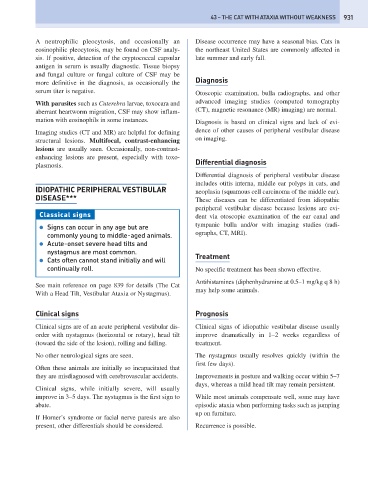Page 939 - Problem-Based Feline Medicine
P. 939
43 – THE CAT WITH ATAXIA WITHOUT WEAKNESS 931
A neutrophilic pleocytosis, and occasionally an Disease occurrence may have a seasonal bias. Cats in
eosinophilic pleocytosis, may be found on CSF analy- the northeast United States are commonly affected in
sis. If positive, detection of the cryptococcal capsular late summer and early fall.
antigen in serum is usually diagnostic. Tissue biopsy
and fungal culture or fungal culture of CSF may be
Diagnosis
more definitive in the diagnosis, as occasionally the
serum titer is negative. Otoscopic examination, bulla radiographs, and other
With parasites such as Cuterebra larvae, toxocara and advanced imaging studies (computed tomography
aberrant heartworm migration, CSF may show inflam- (CT), magnetic resonance (MR) imaging) are normal.
mation with eosinophils in some instances. Diagnosis is based on clinical signs and lack of evi-
Imaging studies (CT and MR) are helpful for defining dence of other causes of peripheral vestibular disease
structural lesions. Multifocal, contrast-enhancing on imaging.
lesions are usually seen. Occasionally, non-contrast-
enhancing lesions are present, especially with toxo-
Differential diagnosis
plasmosis.
Differential diagnosis of peripheral vestibular disease
includes otitis interna, middle ear polyps in cats, and
IDIOPATHIC PERIPHERAL VESTIBULAR neoplasia (squamous cell carcinoma of the middle ear).
DISEASE*** These diseases can be differentiated from idiopathic
peripheral vestibular disease because lesions are evi-
Classical signs dent via otoscopic examination of the ear canal and
● Signs can occur in any age but are tympanic bulla and/or with imaging studies (radi-
commonly young to middle-aged animals. ographs, CT, MRI).
● Acute-onset severe head tilts and
nystagmus are most common.
● Cats often cannot stand initially and will Treatment
continually roll. No specific treatment has been shown effective.
Antihistamines (diphenhydramine at 0.5–1 mg/kg q 8 h)
See main reference on page 839 for details (The Cat
may help some animals.
With a Head Tilt, Vestibular Ataxia or Nystagmus).
Clinical signs Prognosis
Clinical signs are of an acute peripheral vestibular dis- Clinical signs of idiopathic vestibular disease usually
order with nystagmus (horizontal or rotary), head tilt improve dramatically in 1–2 weeks regardless of
(toward the side of the lesion), rolling and falling. treatment.
No other neurological signs are seen. The nystagmus usually resolves quickly (within the
first few days).
Often these animals are initially so incapacitated that
they are misdiagnosed with cerebrovascular accidents. Improvements in posture and walking occur within 5–7
days, whereas a mild head tilt may remain persistent.
Clinical signs, while initially severe, will usually
improve in 3–5 days. The nystagmus is the first sign to While most animals compensate well, some may have
abate. episodic ataxia when performing tasks such as jumping
up on furniture.
If Horner’s syndrome or facial nerve paresis are also
present, other differentials should be considered. Recurrence is possible.

